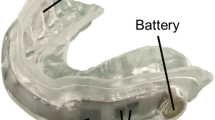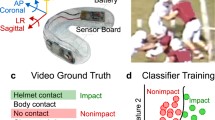Abstract
In this work we present a new physics-informed machine learning model that can be used to analyze kinematic data from an instrumented mouthguard and detect impacts to the head. Monitoring player impacts is vitally important to understanding and protecting from injuries like concussion. Typically, to analyze this data, a combination of video analysis and sensor data is used to ascertain the recorded events are true impacts and not false positives. In fact, due to the nature of using wearable devices in sports, false positives vastly outnumber the true positives. Yet, manual video analysis is time-consuming. This imbalance leads traditional machine learning approaches to exhibit poor performance in both detecting true positives and preventing false negatives. Here, we show that by simulating head impacts numerically using a standard Finite Element head-neck model, a large dataset of synthetic impacts can be created to augment the gathered, verified, impact data from mouthguards. This combined physics-informed machine learning impact detector reported improved performance on test datasets compared to traditional impact detectors with negative predictive value and positive predictive values of 88 and 87% respectively. Consequently, this model reported the best results to date for an impact detection algorithm for American football, achieving an F1 score of 0.95. In addition, this physics-informed machine learning impact detector was able to accurately detect true and false impacts from a test dataset at a rate of 90% and 100% relative to a purely manual video analysis workflow. Saving over 12 h of manual video analysis for a modest dataset, at an overall accuracy of 92%, these results indicate that this model could be used in place of, or alongside, traditional video analysis to allow for larger scale and more efficient impact detection in sports such as American Football.





Similar content being viewed by others
References
Alizadeh, H. V., M. G. Fanton, A. G. Domel, G. Grant, and D. B. Camarillo. A computational study of liquid shock absorption for prevention of traumatic brain injury. Journal of Biomechanical Engineering. 2021. https://doi.org/10.1115/1.4049155
Beckwith, J. G., R. M. Greenwald, J. J. Chu, et al. Head impact exposure sustained by football players on days of diagnosed concussion. Medicine and Science in Sports and Exercise. 2013. https://doi.org/10.1249/MSS.0b013e3182792ed7
Camarillo, D. B., P. B. Shull, J. Mattson, R. Shultz, and D. Garza. An instrumented mouthguard for measuring linear and angular head impact kinematics in American football. Annals of Biomedical Engineering. 2013. https://doi.org/10.1007/s10439-013-0801-y
Cecchi, N. J., A. G. Domel, Y. Liu, et al. Identifying factors associated with head impact kinematics and brain strain in high school American football via instrumented mouthguards. Annals of Biomedical Engineering. 2021. https://doi.org/10.1007/s10439-021-02853-5
Collins, D., S. Raymond, Y. Ai, J. Willams, R. O’Rorke, and M. Tayebi. Acoustic field design in microfluidic geometries via Huygens-Fresnel diffraction and deep neural networks. The Journal of the Acoustical Society of America. 148(4):2707, 2020.
Corrales, M. A., D. Gierczycka, J. Barker, D. Bruneau, M. C. Bustamante, and D. S. Cronin. Validation of a football helmet finite element model and quantification of impact energy distribution. Annals of Biomedical Engineering. 2020. https://doi.org/10.1007/s10439-019-02359-1
Decker, W., A. Baker, X. Ye, P. Brown, J. Stitzel, and F. S. Gayzik. Development and multi-scale validation of a finite element football helmet model. Annals of Biomedical Engineering. 2020. https://doi.org/10.1007/s10439-019-02345-7
Domel, A. G., S. J. Raymond, C. Giordano, et al. A new open-access platform for measuring and sharing mTBI data. Scientific Reports. 11(1):7501, 2021. https://doi.org/10.1038/s41598-021-87085-2
Fanton, M., H. V. Alizadeh, A. G. Domel, et al. Variable area, constant force shock absorption motivated by traumatic brain injury prevention. Smart Materials and Structures. 2020. https://doi.org/10.1088/1361-665X/ab905f
Gabler, L. F., S. H. Huddleston, N. Z. Dau, et al. On-field performance of an instrumented mouthguard for detecting head impacts in American football. Annals of Biomedical Engineering. 2020. https://doi.org/10.1007/s10439-020-02654-2
Gardner, R. C., and K. Yaffe. Epidemiology of mild traumatic brain injury and neurodegenerative disease. Molecular and Cellular Neuroscience. 2015. https://doi.org/10.1016/j.mcn.2015.03.001
Giordano, C., and S. Kleiven. Evaluation of axonal strain as a predictor for mild traumatic brain injuries using finite element modeling. Stapp Car Crash Journal. 58:29–61, 2014.
Giudice, J. S., A. Caudillo, S. Mukherjee, et al. Finite element model of a deformable American football helmet under impact. Annals of Biomedical Engineering. 2020. https://doi.org/10.1007/s10439-020-02472-6
Giudice, J. S., G. Park, K. Kong, A. Bailey, R. Kent, and M. B. Panzer. Development of open-source dummy and impactor models for the assessment of American Football helmet finite element models. Annals of Biomedical Engineering. 2019. https://doi.org/10.1007/s10439-018-02155-3
Hernandez, F., L. C. Wu, M. C. Yip, et al. Six degree-of-freedom measurements of human mild traumatic brain injury. Annals of Biomedical Engineering. 2015. https://doi.org/10.1007/s10439-014-1212-4
Ji, S., W. Zhao, J. C. Ford, et al. Group-wise evaluation and comparison of white matter fiber strain and maximum principal strain in sports-related concussion. Journal of Neurotrauma. 2015. https://doi.org/10.1089/neu.2013.3268
Kleiven, S. Predictors for traumatic brain injuries evaluated through accident reconstructions. Stapp Car Crash Journal. 51:81–114, 2007.
Kuo, C., L. Wu, J. Loza, D. Senif, S. C. Anderson, and D. B. Camarillo. Comparison of video-based and sensor-based head impact exposure. PLoS ONE. 2018. https://doi.org/10.1371/journal.pone.0199238
Ling, J., A. Kurzawski, and J. Templeton. Reynolds averaged turbulence modelling using deep neural networks with embedded invariance. Journal of Fluid Mechanics. 2016. https://doi.org/10.1017/jfm.2016.615
Liu, Y., A. G. Domel, N. J. Cecchi, et al. Time window of head impact kinematics measurement for calculation of brain strain and strain rate in American football. Annals of Biomedical Engineering. 2021. https://doi.org/10.1007/s10439-021-02821-z
Liu, Y., A. G. Domel, S. A. Yousefsani, et al. Validation and comparison of instrumented mouthguards for measuring head kinematics and assessing brain deformation in football impacts. Annals of Biomedical Engineering. 2020. https://doi.org/10.1007/s10439-020-02629-3
Lucke-Wold, B., K. Pierre, F. Dawoud, and M. Guttierez. Changing the culture: Improving helmet utilization to prevent traumatic brain injury. Journal of Emergency Medicine Forecast. 3(1):1020, 2020.
Mao, H., L. Zhang, B. Jiang, et al. Development of a finite element human head model partially validated with thirty five experimental cases. Journal of Biomechanical Engineering. 2013. https://doi.org/10.1115/1.4025101
Meaney, D. F., and D. H. Smith. Biomechanics of concussion. Clinics in Sports Medicine. 2011. https://doi.org/10.1016/j.csm.2010.08.009
O’Connor, K. L., S. Rowson, S. M. Duma, and S. P. Broglio. Head-impact-measurement devices: A systematic review. Journal of Athletic Training. 2017. https://doi.org/10.4085/1062-6050.52.2.05
Raissi, M. Deep hidden physics models: Deep learning of nonlinear partial differential equations. Journal of Machine Learning Research. 19:1, 2018.
Raissi, M., P. Perdikaris, and G. E. Karniadakis. Physics-informed neural networks: A deep learning framework for solving forward and inverse problems involving nonlinear partial differential equations. Journal of Computational Physics. 2019. https://doi.org/10.1016/j.jcp.2018.10.045
Raissi, M., A. Yazdani, and G. E. Karniadakis. Hidden fluid mechanics: Learning velocity and pressure fields from flow visualizations. Science. 2020. https://doi.org/10.1126/science.aaw4741
Raymond, S. J., D. J. Collins, R. O’Rorke, M. Tayebi, Y. Ai, and J. Williams. A deep learning approach for designed diffraction-based acoustic patterning in microchannels. Scientific Reports. 10(1):1–12, 2020.
Raymond, S. J., B. D. Jones, and J. R. Williams. Modeling damage and plasticity in aggregates with the material point method (MPM). Computational Particle Mechanics. 6(3):371–382, 2019.
Raymond, S. J., B. D. Jones, and J. R. Williams. Fracture shearing of polycrystalline material simulations using the material point method. Computational Particle Mechanics. 2020:1–14, 2020.
Raymond, S. J., J. Maragh, A. Masic, and J. R. Williams. Towards an understanding of the chemo-mechanical influences on kidney stone failure via the material point method. PLoS ONE. 15(12):e0240133, 2020.
Raymond SJ, Camarillo DB. Applying physics-based loss functions to neural networks for improved generalizability in mechanics problems. Published online April 30, 2021. Accessed August 2, 2021. http://arxiv.org/abs/2105.00075
Sahler, C. S., and B. D. Greenwald. Traumatic brain injury in sports: A review. Rehabilitation Research and Practice. 2012. https://doi.org/10.1155/2012/659652
Shenton, M. E., H. M. Hamoda, J. S. Schneiderman, et al. A review of magnetic resonance imaging and diffusion tensor imaging findings in mild traumatic brain injury. Brain Imaging and Behavior. 2012. https://doi.org/10.1007/s11682-012-9156-5
Vahid Alizadeh, H., M. Fanton, and D. B. Camarillo. Collapsible fluid-filled fabric shock absorber with constant force. Journal of Intelligent Material Systems and Structures. 2021. https://doi.org/10.1177/1045389X211023578
Viano, D. C., C. Withnall, and D. Halstead. Impact performance of modern football helmets. Annals of Biomedical Engineering. 2012. https://doi.org/10.1007/s10439-011-0384-4
Wang, J. X., J. L. Wu, and H. Xiao. Physics-informed machine learning approach for reconstructing Reynolds stress modeling discrepancies based on DNS data. Physical Review Fluids. 2017. https://doi.org/10.1103/PhysRevFluids.2.034603
Wieghold, S., Z. Liu, S. J. Raymond, et al. Detection of sub-500-μm cracks in multicrystalline silicon wafer using edge-illuminated dark-field imaging to enable thin solar cell manufacturing. Solar Energy Materials and Solar Cells. 2019. https://doi.org/10.1016/j.solmat.2019.03.033
Wu, L. C., C. Kuo, J. Loza, et al. Detection of American football head impacts using biomechanical features and support vector machine classification. Scientific Reports. 2018. https://doi.org/10.1038/s41598-017-17864-3
Wu, L. C., V. Nangia, K. Bui, et al. In vivo evaluation of wearable head impact sensors. Annals of Biomedical Engineering. 2016. https://doi.org/10.1007/s10439-015-1423-3
Wu, J. L., H. Xiao, and E. Paterson. Physics-informed machine learning approach for augmenting turbulence models: A comprehensive framework. Physical Review Fluids. 2018. https://doi.org/10.1103/PhysRevFluids.3.074602
Wu, L. C., L. Zarnescu, V. Nangia, B. Cam, and D. B. Camarillo. A head impact detection system using SVM classification and proximity sensing in an instrumented mouthguard. IEEE Transactions on Biomedical Engineering. 2014. https://doi.org/10.1109/TBME.2014.2320153
Zhou, Z., A. G. Domel, X. Li, et al. White matter tract-oriented deformation is dependent on real-time axonal fiber orientation. Journal of Neurotrauma. 2021. https://doi.org/10.1089/neu.2020.7412
Zhou, Z., X. Li, Y. Liu, et al. Towards a comprehensive delineation of white matter tract-related deformation. Journal of Neurotrauma. 2021. https://doi.org/10.1089/neu.2021.0195
Acknowledgments
This research was supported by the Pac-12 Conference’s Student-Athlete Health and Well-Being Initiative, the National Institutes of Health (R24NS098518), and the Taube Stanford Children’s Concussion Initiative and Stanford Department of Bioengineering.
Conflict of interest
The authors declare that they have no known competing financial interests or personal relationships that could have appeared to influence the work reported in this paper.
Author information
Authors and Affiliations
Corresponding author
Additional information
Associate Editor Stefan M. Duma oversaw the review of this article.
Publisher's Note
Springer Nature remains neutral with regard to jurisdictional claims in published maps and institutional affiliations.
Rights and permissions
About this article
Cite this article
Raymond, S.J., Cecchi, N.J., Alizadeh, H.V. et al. Physics-Informed Machine Learning Improves Detection of Head Impacts. Ann Biomed Eng 50, 1534–1545 (2022). https://doi.org/10.1007/s10439-022-02911-6
Received:
Accepted:
Published:
Issue Date:
DOI: https://doi.org/10.1007/s10439-022-02911-6




